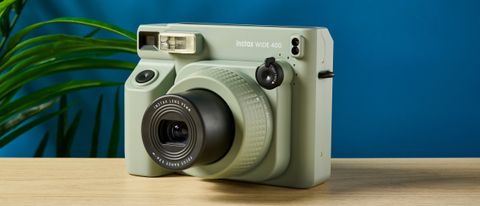Tom's Guide Verdict
The Fujifilm Instax Wide 400 succeeds the Wide 300 and improves on its best qualities. It’s an easy-to-use camera with an ergonomic layout, and the wide prints it produces are bright and detailed. The camera comes with a handy macro lens and selfie mirror attachment, an adjustment accessory, and a new self timer. However, low-light performance isn’t great, and there’s no double exposure mode or manual flash control.
Pros
- +
Detailed, lovely wide prints
- +
Easy to use
- +
Great value for money
- +
Improved ergonomic design
- +
Retro aesthetic
- +
Handy self-timer
Cons
- -
Uses disposable batteries
- -
Subpar low-light performance
- -
No double exposure mode
- -
No manual flash control
Why you can trust Tom's Guide
Holding a physical print in my hand takes me back to my childhood bedroom when I’d go through our holiday photo album with my family. I’ve been looking forward to getting my hands on the new Fujifilm Instax Wide 400 for that reason: wide format prints that carry a sense of nostalgia.
It’s the much awaited successor to the 10-year-old Instax Wide 300 — one of the best instant cameras around — which was launched all the way back in 2014. Fujifilm's largest instant camera now has a fresher look in a gorgeous sage green colorway, with a rounded body for better handling. The wide film captures a lot of the scene, and the prints turn out bright and detailed. Easy-to-use with only one button, this retro beast can be used by anyone. There are a few things missing though, like double exposure mode and manual flash control.
Does it deserve a spot amongst the best? Read my full Fujifilm Instax Wide 400 review for the complete breakdown.
Fujifilm Instax Wide 400: Specs
| Price | $149 / £129 (camera only) | $197 / £168 (bundle) |
| Lens | 95mm retractable lens |
| Viewfinder | 0.37x |
| Exposure control | Automatic, Lv 10.5 to 15 (ISO 800) |
| Shutter | 1/64 to 1/200 seconds |
| Aperture | 95mm f/14 |
| Flash | Automatic |
| Flash refresh time | 7 seconds |
| Self-timer | 4s, 6s, 8s, 10s |
| Power | 4 x AA batteries |
| Dimensions | 6.37 x 4.84 x 3.85 inches |
| Weight | 1.35lbs (616g) |
| Film used | Instax Wide film |
| Film development time | Up to 90 seconds |
| Cost per print | $1.11 |
Fujifilm Instax Wide 400 review: Cheat sheet
- What is it? Fujifilm’s largest instant camera that utilizes wide film
- Who is it for? For people who want to capture memories in physical prints
- How much does it cost? The Fujifilm Instax Wide 400 is available for $149 / £129
- What do we like? The prints turn out bright and detailed, the ease of use and ergonomics, the self-timer, the retro aesthetic, and the fact that it’s great value for money
- What don’t we like? It uses disposable batteries, low-light performance isn’t great, no double exposure mode or manual flash control
Fujifilm Instax Wide 400 review: Price & availability
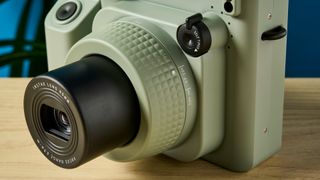
The Fujifilm Instax Wide 400 launched in Summer 2024 and costs $149 / £129 (camera only). If you’re in the United States of America, you can also get the bundle which includes 20 films and a shoulder bag, for $197. The Instax Wide 400 is available in one color only: sage green.
There aren’t a lot of instant cameras that use wide film, so the Instax Wide 400 finds itself competing with the likes of the Lomo’Instant Wide ($169).
Fujifilm Instax Wide 400 review: Design & build quality

The Fujifilm Instax Wide 400 is a chonky boi, measuring 6.37 x 4.84 x 3.85 inches. Even though it has a large footprint and it weighs 1.35lbs, it never feels too heavy to carry around, and I even found it comfortable to hold with one hand. While its body is made entirely of plastic, it doesn’t feel cheap.

On the camera’s underside and to the right, you’ll find an indent. This is for the new angle-adjustment accessory which you can slot in to prop the Instax Wide 400 at two different angles. Neat! In conjunction with the self-timer (4s, 6s, 8s, 10s), it works well when placed on a horizontal surface.
The Instax Wide 400 is available in one color only: sage green. To me, it looks lovely and fresh, and adds charm to the retro aesthetic.
Fujifilm Instax Wide 400 review: Lens & viewfinder
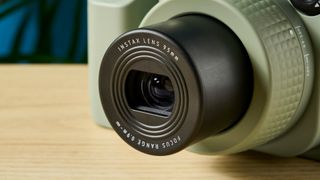
The Fujifilm Instax Wide 400 has a retractable lens with two shooting ranges: 0.9m-3m for normal shots, and 3m-∞ for landscape shots.
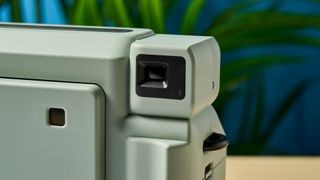
The optical viewfinder (OVF) is small but easy to use and comfortable to look through, and it has a relatively small 0.37x magnification. Providing an always-in-focus view of your scene, the OVF has two circle markers to assist you in lining up shots. The OVF sits above the grip — opposite of where it was on the Wide 300.

The Instax Wide 400’s 95mm f/14 lens is equivalent to that of the 35mm focal length of a full-frame camera. The smaller aperture is handy for shooting in bright conditions, as Instax film is rated at ISO 800.
In the box, you’ll find a clip-on macro lens attachment that doubles as a selfie mirror. Given the camera’s large footprint, I’m surprised it doesn’t have a built-in selfie mirror — Fujifilm had plenty of space for one — but hey, an accessory is better than none.
Fujifilm Instax Wide 400 review: Controls

As I mentioned before, the Fujifilm Instax Wide 400 borrows but improves on its predecessor’s design. It’s designed to be held with your fingers curled around the handgrip on the right hand side of the camera, and your thumb on the back of it.
It’s designed for instant shooting, so there’s only one button you need to familiarize yourself with: the shutter button on the handgrip. When pressed, the button provides good tactile feedback. The button sits at a 45-degree angle, which feels natural under your finger, making it ergonomically-friendly — it’s a lot more comfortable than the shutter button on the Polaroid Go Gen 2 ($79).
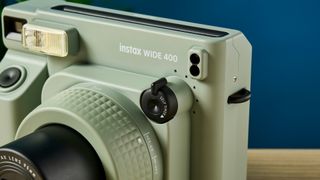
The only other control on the camera is a self-timer dial above the lens, which lets you set the timer at increments of 2 seconds up to 10. There’s no physical button to power up the Instax Wide 400. All you need to do is twist the dial, and you’re ready to go within seconds.
Fujifilm Instax Wide 400 review: Image & print quality
The Fujifilm Instax Wide 400 doesn’t boast any fancy shooting capabilities. You don’t get any manual control over the flash, and there isn’t any double exposure mode either, something I loved while testing the Polaroid Go Gen 2. If you want more creative control, consider the Fujifilm Instax mini 99 ($199) instead.
But the image quality you get while shooting straightforward shots is gorgeous. The prints turned out bright and detailed with a little extra saturation, while maintaining a retro aesthetic. The wide film lets you capture a lot of the scene and add context to photos, making the Instax Wide 400 great for landscape and group shots. The automatic flash has a range of up to 3m so it has no effect on distant objects, but it works like a charm when you’re photographing people or in bright conditions.



Photographing outdoors during the day is where the Instax Wide 400 really shines. I took the camera with me on my favorite walk in Bath, U.K., and photographed different scenes. Most prints turned out great, as can be seen in the gallery above.

The Instax Wide 400 has a narrow dynamic range, though, so when you’re photographing a scene with very bright light and dark areas, the prints end up with bright highlights and blackened shadows. This can be seen in the photo of my partner (above), which was shot in our bright living room. Light easily reaches the shelves behind her but in the print, the area appears very dark.

This is also the case with selfies. The macro lens/selfie mirror attachment lets you shoot objects that are 40-50cm away from the lens. As can be seen above, while the selfie turned out detailed, you can’t see any of the background as it’s too dark. Not a massive issue, but it’s something to keep in mind. The selfie was taken with my partner’s arms stretched out as much as possible.


Focusing itself takes a little trial and error, but once you get used to it, the Instax Wide 400 produces sharp images. For example, in the photo of the swan in the gallery above, the swan is out of focus while the shrubs surrounding her aren’t — and they weren’t the main subject. In contrast, the second photo in the gallery blurs the bridge just enough to put the focus on the river. Don’t let failed prints put you off — that’s the beauty of an instant camera.

But like many instant cameras, the Instax Wide 400 struggles in low light (above). Most instant cameras aren’t built for low-light photography. My expectations were low as the Polaroid Go Gen 2 and the Instax Mini 8 came up short in dim conditions too.

As with focusing, shooting with the macro lens attachment on also takes some getting used to. The dotted circle in the OVF serves as a guide, but I initially struggled with getting the composition right. I tried to take three macro shots and two of them failed, but the one above was a success, with the little teardrop trinket in focus and the leaves of the plant blurring perfectly.
Fujifilm Instax Wide 400 review: App

If you want to share your Fujifilm Instax Wide 400 prints on social media, the intuitive Instax UP! app on Android and iOS makes it easy to scan them. Once you’ve scanned your print, you can edit the contrast, brightness, saturation and color temperature. Furthermore, the app has a handy “remove reflections” feature which works well — but that will depend on shooting conditions. You can also arrange the scanned prints onto a wooden surface to share on social media.
This app is great if, like me, you don’t own a scanner. All the photos in this review were scanned using the Instax UP! app on my Google Pixel 7 Pro.
Fujifilm Instax Wide 400 review: Film cost & yield

The Fujifilm Instax Wide 400 uses Instax Wide film packs, which generally cost about $18 / £16 per double film pack (20 pieces of film) — so you’re paying $1.11 per picture. This is similar to Polaroid’s square film, where you pay approximately $1.12 per print. With wide film, you capture more of the scene and frankly, better colors.
Fujifilm Instax Wide 400 review: Battery life
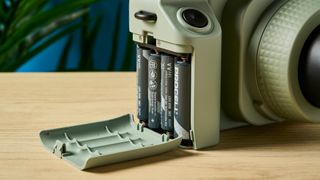
Similar to other Fujifilm Instax cameras, such as the Instax mini 40 ($100) or the Instax mini 12 ($69), the Instax Wide 400 uses disposable AA batteries — four, to be precise. While disposable batteries aren’t environmentally-friendly, they keep your camera from running out of juice.
Fujifilm claims that one set of batteries will last you approximately 100 shots, but this depends on the usage conditions. The camera also has a handy auto power off timer, so it will automatically shut down after five minutes to conserve power. Our review unit came with 20 pieces of film so I couldn’t drain the Instax Wide 400’s battery completely.
Fujifilm Instax Wide 400 review: Verdict

So, is the Fujifilm Instax Wide 400 worth the money? Certainly. It’s a big camera but I didn’t have any issues carrying it around my neck or my shoulder. Fujifilm has improved on the predecessor’s design by giving the Instax Wide 400 a rounded body for better handling — I had no problems holding it with one hand. While it’s ideal for landscape and group shots, the selfie mirror attachment lets you take nice selfies too, and the new self-timer gives you more control.
But if you want an instant camera that performs better in low-light conditions, I’d recommend the Fujifilm Instax mini 40 instead. And if you want more exposure compensation controls and double exposures, you should check out the Fujifilm Instax mini 99.
I’ve loved shooting with the Instax Wide 400, and I’ve already pinned up the bright and detailed prints onto my pinboard — it’s definitely one of the best instant cameras around.

Nikita is a Staff Writer on the Reviews team at Tom's Guide. She's a lifelong gaming and photography enthusiast, always on the lookout for the latest tech. Having worked as a Sub Editor and Writer for Canon EMEA, she has interviewed photographers from all over the world and working in different genres. When she’s not working, Nikita can usually be found sinking hours into RPGs on her PS5, out on a walk with a camera in hand, at a concert, or watching F1. Her work has appeared in several publications including Motor Sport Magazine, NME, Marriott Bonvoy, The Independent, and Metro.
